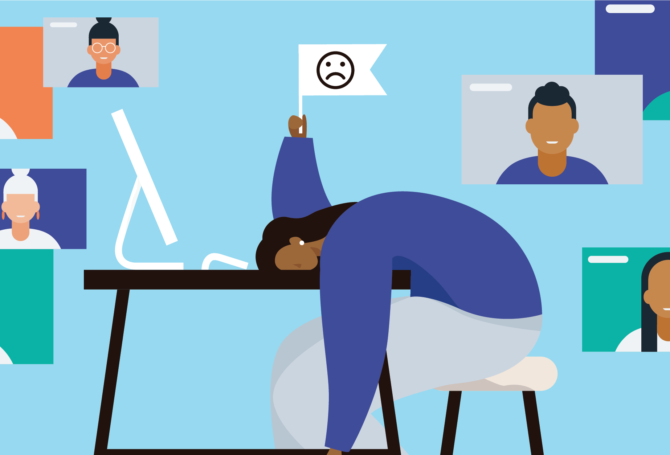
Pre-pandemic commuting brought workers face-to-face with car tailpipes. Pandemic videoconferences have brought workers face-to-face with other people, sometimes all day long, causing Zoom fatigue.
Zoom fatigue is a commonly acknowledged malady affecting the remote worker who clicks from one videoconference to another. While there isn’t any peer-reviewed explanation for Zoom fatigue, Jeremy Bailenson, a media psychologist at Stanford University, has offered four possibilities based on his experience and observation. He believes Zoom fatigue results from some combination of excessive close-up eye gaze, cognitive overload, increased self-evaluation from staring at yourself and constraints on physical mobility.

Excessive close-up eye gaze
We have unspoken rules of appropriate personal distance. We are uncomfortable standing too close or staring at someone’s face. Zoom’s frame format crushes those norms, putting videoconference participants in each other’s laps and staring at everyone’s faces.
Bailenson says such non-stop, intimate face-to-face interaction is the province of romance, not work. In the close quarters of a crowded elevator, we avoid invading someone’s personal space by looking down. That’s harder to do in a Zoom meeting without appearing to be distracted.
Bailenson cites research indicating being stared at while speaking stimulates a physiological response, which can be tiring. Zoom conferences effectively convert all participants into speakers who feel the tiring effects of constant eye gaze.
Cognitive overload
Humans communicate a lot through nonverbal cues. On Zoom, it is harder to pick up on body language when staring at everyone’s faces. As a result, Bailenson says, Zoom participants are overloaded with facial and vocal cues, which can be misleading.
Direct eye contact, which conveys meaning when people meet in person, may just be a vestige of Zoom’s online format. A side glance, which in person can be meaningful, may just be a reflex when the dog or a small child enters the room. Tonal inflections can result from poor audio quality or a bad internet connection. Hand gestures can be especially revealing, except Zoom participants can’t see each other’s hands.
With fewer nonverbal cues, Zoom participants are forced to magnify the cues they get, leading sometimes to faulty conclusions based on inadequate information. That can be frustrating and tiresome. In this respect, Bailenson argues, Zoom videoconferencing isn’t much better than a telephone conference call, or possibly worse by offering a postage stamp picture of participants with few nonverbal cues.
All-Day Mirror
Participating in repetitive Zoom meetings, Bailenson says, is like looking in the mirror at yourself all day. You can hide a self-view, but Zoom’s default is seeing yourself on your computer screen. This unintentional narcissism inevitably leads to more self-awareness and critical self-examination, which can be stressful, draining, depressing and certainly boring.
Research indicates, according to Bailenson, that the distress of so much self-viewing is worse with women than men, but the effect is negative for both, regardless whether the awareness and self-valuation is outer-directed or inner-directed.
With fewer nonverbal cues, Zoom participants are forced to magnify the cues they get, leading sometimes to faulty conclusions based on inadequate information, which can be frustrating and tiresome.
Reduced Mobility
Remote office spaces can be nooks and crannies, with or without windows. Add to that the confined video space of a Zoom frame, and you have remote workers who feel penned in. The proximity of faces on a computer screen amplifies the isolation, even when our eyes surf people’s backgrounds to get a sense of perspective and escape a closed environment.
In in-person meetings, participants escape monotony by doodling, standing up to stretch or refilling their water glass. There is no equivalent escape in Zoom. Second-generation videoconferencing platforms provide “spatial” movement so you can retreat to a separate “room” for discreet conversations or “roam” around an office, much like a video game. That can help, Bailenson says, but probably not fully erase the sense of immobility of Zoom participants.
Bailenson insists he isn’t dissing Zoom or videoconferencing. “Families, friends, students, teachers and employees have benefited immensely from such a robust and available communication tool during Covid-19,” he says. “The meteoric rise of Zoom has been fascinating to watch as a media psychologist. In less than a year, many people have seamlessly integrated Zoom into their work and social lives, and affordances such as screen-sharing have become critical tools.”
The purpose of his hypothesizing about the pitfalls of Zoom, Bailenson explains, is to encourage design improvements that mimic in-person, face-to-face meetings and thereby reduce the fatigue factor of Zoom calls. A previous Managing Issues blog identified other platform options that allow more online elbow room to move around and interact in ways other than face-to-face in grids.
Another beneficial outcome is altering some onscreen habits, as you might do in in-person meetings, to minimize fatigue. Like standing up, stretching, checking your email inbox and going to the restroom.
“Regardless of the medium, it is important to acknowledge that meetings in general can be fairly tiring, as can commuting from one location to another, which Zoom eliminates,” Bailenson says. “Perhaps a driver of Zoom fatigue is simply that we are taking more meetings than we would be doing face-to-face.” Exchanging emails might be the painless cure for that.




